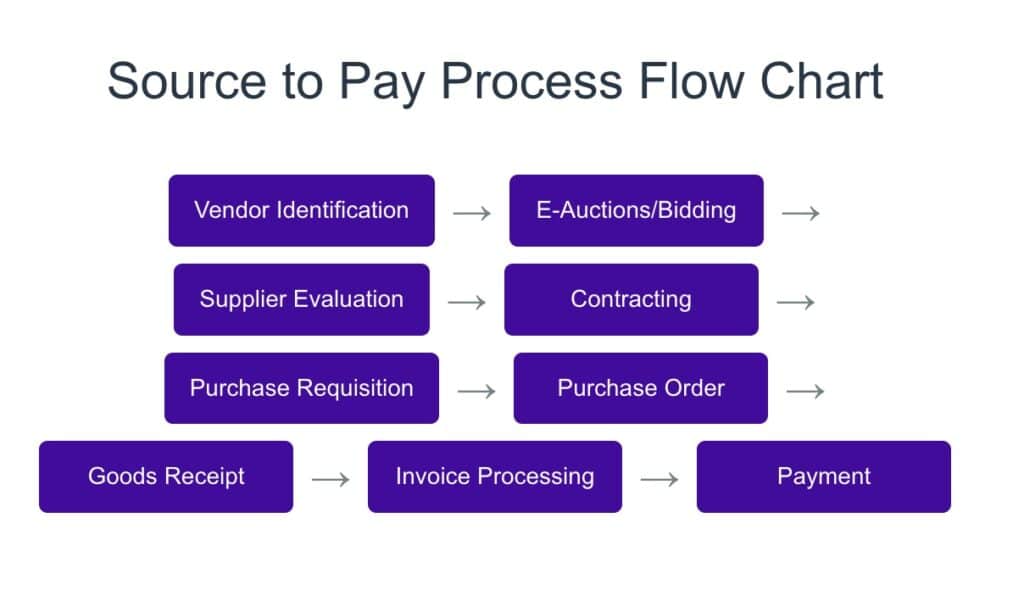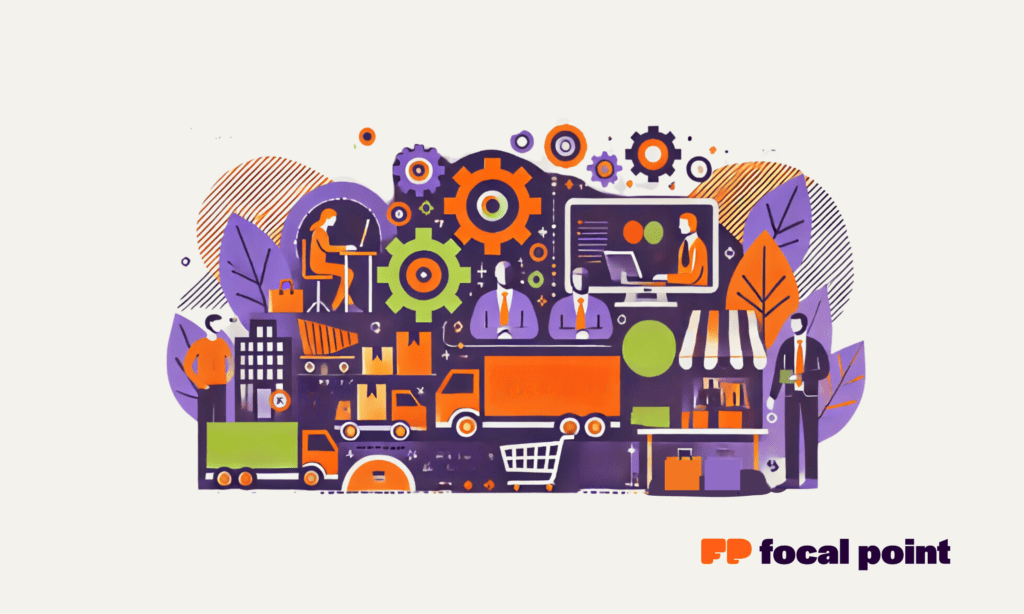Are you tired of dealing with inefficient procurement processes that hinder your organization’s growth and profitability? Elevate your source-to-pay (S2P) strategy to unlock the full potential of your supply chain.
Source-to-Settle, or S2S, or Procure-to-Pay (P2P), encompasses the entire lifecycle of purchasing goods and services.
By embracing a comprehensive S2P and P2P approach, you will streamline your procurement operations, reduce costs, mitigate risks, and foster collaborative supplier relationships that drive innovation and competitive advantage.
This comprehensive article will explore the intricacies of source-to-pay, its key steps, benefits, and best practices. From vendor identification and selection to contract negotiation and payment management, we will equip you with the knowledge and tools necessary to optimize your S2P process and unlock the true value of strategic sourcing.
Source-to-Pay and Procure-to-Pay
Welcome to the technology advances of 2024, where your procurement team effortlessly navigates the complexities of sourcing, contracting, and invoice management with your source-to-pay platform.
With the right source-to-pay strategies and cutting-edge software solutions, such as Focal Point’s procurement platform, you will transform your procurement function into a well-oiled machine that delivers unparalleled efficiency, transparency, and cost savings.
Embrace the power of automation, data-driven decision-making, and continuous process improvement to propel your organization to new heights of procurement excellence.
Key Takeaways
- Source to Pay encompasses the entire procurement lifecycle, from sourcing to payment
- Automating S2P processes can lead to significant cost savings, risk mitigation, and operational efficiency
- Collaborative supplier relationships foster innovation and competitive advantage
- Cutting-edge S2P software solutions offer powerful automation and analytics capabilities
- Mastering Source to Pay requires a strategic approach, best practices, and continuous improvement
Understanding Source to Pay (S2P)
Source to Pay (S2P) is a comprehensive approach to optimizing the entire procurement process, from sourcing goods and services to making payments. By leveraging S2P solutions, businesses can streamline their procurement workflows, reduce costs, and enhance supplier relationships.
In this section, we’ll explore the meaning of Source to Pay, the key steps involved, and the benefits of implementing an S2P strategy.
What Is Source to Pay (S2P)?
Source to Pay (S2P) refers to the end-to-end procurement process encompassing all activities from identifying potential suppliers to making final payments. It is a holistic approach to managing the procurement lifecycle, aiming to optimize efficiency, reduce costs, and ensure compliance.
By leveraging advanced source-to-pay software, businesses can automate the procurement process, improving process efficiency and bottom-line savings.
Key Steps in the Source to Pay Process
- Defining requirements and establishing vendor expectations
- Identifying potential suppliers and examining a list of potential vendors
- Selecting the ideal vendor through a structured selection procedure
- Negotiating and approving contracts with selected suppliers
- Creating and processing purchase orders and requisitions
- Receiving goods and services and approving delivery
- Processing invoices and making final payments
Throughout these steps, S2P technology enhances spend visibility, simplifies contract management, and facilitates vendor evaluation against key performance indicators.
Automating the S2P workflow enables quick creation and approval of purchase orders, reduces requisition errors, and saves substantial time and cost by efficiently handling non-PO invoices and exceptions.

Benefits of Implementing Source to Pay
- Cost reduction through improved process efficiency and reduced maverick spending
- Enhanced accuracy and compliance with procedures, contracts, and regulations
- Improved supplier relationships and performance management
- Valuable data analytics and insights for smarter financial decision-making
- Increased spend under management and greater policy enforcement
- Reduced dependence on a static list of preferred suppliers, fostering healthy competition
- Empowered procurement teams focused on strategic endeavors rather than routine tasks
Implementing a Source to Pay process requires organizational buy-in and support from different business functions, necessitating effective change management and leadership alignment.
The benefits of S2P, such as cost savings, enhanced compliance, and improved supplier relationships, make it a worthwhile investment for businesses seeking to optimize their procurement strategy.
Comprehensive Source-to-Pay Process Overview
The Source-to-Pay (S2P) process is a comprehensive approach to procurement that encompasses all activities from initial sourcing of goods and services to final payment. By implementing an effective S2P strategy, businesses can connect all vendors and suppliers onto a single platform, enhancing performance through improved procurement efficiency.
Vendor Identification and Selection
The first step in the S2P process is identifying and selecting the right vendors. This involves conducting a thorough spend analysis to determine specific requirements, quantities, suppliers, and budget alignment.
Advanced e-sourcing tools can help in effective vendor data gathering and analysis, potentially saving 18% to 40% of costs. You can read more on the best practices for success in our article on supplier relationship management
E-Auctions and Competitive Bidding
Once potential vendors are identified, the next step is to invite multiple suppliers through RFI/RFP and conduct online auctions or competitive bidding.
Effective source-to-pay software offers real-time data analysis, competitive supplier bidding, vendor qualification, and online negotiations, leading to cost savings and streamlined workflows.
Supplier Evaluation and Vetting Involved in Source to Pay
A thorough evaluation and vetting process is crucial before awarding business to the selected supplier(s). This includes assessing suppliers based on their qualifications, experience, financial standing, and track record.
Statistical benchmarks for evaluating suppliers include cycle times for e-invoicing and purchase orders, on-time delivery rates, pricing comparisons, and other defined metrics.
Contracting and Negotiation Tactics
Once the preferred supplier(s) are selected, the next step is negotiating the contract.
This requires creating, negotiating, and approving contracts for procurement.
Source-to-pay automation solutions enhance the overall contract management process by providing benefits such as contract lifecycle management and strategic sourcing support.
WATCH: S2P In Procurement with Unplanned Work
Payment and Delivery Management
Effective payment and delivery management is crucial for maintaining good supplier relationships. This involves issuing purchase orders based on requisitions, receiving and conducting quality inspections, and ensuring timely payments.
Automation software in AP departments can reduce manual processes for both buyers and suppliers, improve efficiency, reduce costs, digitize invoices, and automate payment processes.
Leveraging Automation Software
Large and complex organizations are increasingly adopting automation software for source-to-pay processes to speed up operations, enhance procurement efficiency, and manage spending effectively.
Source-to-Pay automation enhances efficiency, reduces manual tasks, cuts costs, ensures accuracy and compliance, provides data-driven insights, improves supplier relationships, and enables better risk management.
Maximizing Margins and Efficiencies
By leveraging S2P software that employs technology, big data, and digital networks, businesses can streamline the process of negotiating, contracting, and paying for goods and services, ultimately leading to increased procurement visibility and larger sourcing savings.
Integration of sourcing, procurement, and AP automation software with an ERP system further enhances S2P solutions, maximizing margins and efficiencies throughout the procurement lifecycle.
Source to Pay vs. Procure to Pay
While both source-to-pay (S2P) and procure-to-pay (P2P) form integral components of the procurement lifecycle, they differ in scope and strategic focus.
Understanding the nuances between these two processes is crucial for optimizing your procurement strategy and driving business value.
Scope and Strategic Focus Comparison
Source-to-pay encompasses a broader scope than procure-to-pay, as it includes strategic sourcing activities such as supplier onboarding and management and contract management.
On the other hand, procure-to-pay primarily integrates the procurement of goods or services and accounts payable.
S2P promises greater spend efficiency and efficacy while reducing costs, whereas P2P prioritizes cost savings through real-time insights, reduced purchase order cycle times, invoice processing efficiency improvements, and streamlined spend management.
Supplier Relationship Management
Effective supplier relationship management is a key differentiator between source-to-pay and procure-to-pay processes. S2P expands on P2P by including contract management and strategic sourcing to identify new vendors to meet demand.
Strategic sourcing in source-to-pay involves identifying, assessing, selecting, and building a pool of dependable suppliers.
This proactive approach to supplier management enables organizations to negotiate favorable contracts, mitigate risks, and foster long-term partnerships.
Impact on Business Strategy
Choosing between source-to-pay and procure-to-pay significantly impacts an organization’s overall business strategy. S2P provides value in preventative optimization by leveraging data insights for vendor evaluation, contract management, and detailed strategic sourcing. By integrating the entire supply chain into the S2P system, companies can achieve continuous improvement driven by automated workflows and real-time data management.
This holistic approach aligns procurement with broader business objectives, driving innovation and competitive advantage.
Detailed Step-by-Step Comparison
To further distinguish between source-to-pay and procure-to-pay, let’s examine the detailed steps involved in each process:
- Procure-to-pay steps include identifying the need, vendor selection, generating a purchase requisition, purchase order creation, receiving goods, processing the invoice, and releasing the payment. Traditional P2P systems use tools like ERP software and spend analysis to introduce process automation, efficiency, and accuracy improvements across procurement functions.
- Source-to-pay, on the other hand, involves additional steps such as contract management, which entails negotiating details regarding price, delivery, payment terms, quantity, and quality of goods/services. Supplier onboarding is another critical step in source-to-pay, including registration on a supplier portal and reviewing critical information. S2P also involves sourcing analysis, bid preparation, bidding, review, reward, contract negotiation, creation, and management.
While procure-to-pay software comprises all the steps explained above in procure-to-pay, S2P benefits from using procure-to-pay software that supports supply chain and vendor management.
Adding source-to-pay to the procure-to-pay process can lead to better supplier management, streamlined workflows, reduced maverick spend, optimized purchase terms, pricing, and customer service.
Optimizing Your Source to Pay Process – S2P Automation

Streamlining your Source to Pay (S2P) process is crucial for maximizing efficiency, reducing costs, and fostering strong supplier relationships.
By leveraging automation and technology, you can significantly enhance the speed and accuracy of your procurement activities.
Automating Source-to-Pay processes minimizes manual tasks, ensures a seamless data flow across the procurement lifecycle, and reduces cycle times.
Utilizing Automation and Technology
Embracing procurement software and artificial intelligence enables data-driven decision making and strategic planning.
Source-to-pay automation integrates sourcing, purchasing, receiving, paying for, and accounting for goods and services through advanced software solutions.
Automation tools can significantly reduce costs associated with inefficient manual procurement processes. By eliminating tedious manual tasks and reducing human errors, Source-to-Pay automation improves ROI, enhances visibility, increases collaboration, and reduces complexity and confusion.
Effective Supplier Evaluation and Onboarding
Thorough supplier evaluation and onboarding processes are essential for selecting reliable and capable vendors. By implementing a comprehensive supplier management system, you can streamline the onboarding process, ensure compliance with policies, and maintain a single source of truth for vendor information.
Effective supplier evaluation and vetting, as part of the Source to Pay lifecycle process, contribute to optimizing procurement and financial operations.
Data-Driven Decision Making – Source-to-Pay Software
Leveraging big data analytics and artificial intelligence empowers organizations to make informed, data-driven decisions.
When harnessing the power of data, you can identify trends, forecast demand, and optimize spend management. Improved transparency provided by a streamlined P2P process allows for better monitoring of a company’s spend.
Utilizing spend analysis and indirect procurement strategies as part of the Source-to-Pay categories further enhances decision-making and cost savings.
Best Practices for Process Efficiency
Implementing best practices in Source-to-Pay is crucial for optimizing procurement and financial operations.
Standardizing procedures, enhancing collaboration, and leveraging automation opportunities in the Source-to-Pay process drive efficiency and cost savings.
Streamlining the P2P process, which typically includes identifying needs, creating a requisition, submitting a purchase order, receiving goods or services, approving the invoice, and paying the vendor, can significantly improve efficiency.
Benchmarking Procurement KPIs
Measuring and benchmarking key performance indicators (KPIs) is essential for assessing the effectiveness of your Source to Pay process. By tracking metrics such as cycle times, cost savings, supplier performance, and compliance rates, you can identify areas for improvement and drive continuous optimization.
A well-optimized P2P process can enhance a company’s agility in responding to market changes and supply chain disruptions.
Source to Pay Software Solutions
Streamlining your procurement process is crucial for optimizing efficiency and reducing costs. Source-to-pay software solutions offer a comprehensive approach to managing the entire procurement lifecycle, from sourcing and supplier selection to contract management, purchasing, invoicing, and payment.
A key benefit of source to pay is that businesses can achieve significant cost savings and improve procurement performance by automating and integrating these processes.
Leading S2P Software Platforms
Several leading sourcing and procurement software platforms have emerged to address the needs of businesses across various industries.
Coupa, a Focal Point partner and prominent player in the market, offers a cloud-based platform that streamlines procurement, expense management, and accounts payable processes.
Focal Point Procurement and Coupa are recognized for their comprehensive source-to-pay systems, which provide robust sourcing, contract management, and spending analysis features.
Source-to-pay software platforms can automate tasks such as supplier management, spend analysis, invoice processing, negotiation, and contract management, streamlining the entire procurement process.
These solutions utilize big data and digital technologies to enhance procurement efficiency.
Automating source-to-pay processes can reduce spend up to 3.5 percent, providing businesses with significant cost savings opportunities.
However, there are limits of S2P Software as this white paper demonstrates.
Features to Look For
When evaluating source to pay software solutions, there are key features to consider. User-friendly interfaces ensure easy adoption and navigation for procurement teams. Robust reporting and analytics capabilities provide valuable insights into spend patterns, supplier performance, and potential areas for improvement.
Seamless integration with existing ERP systems and other business applications is crucial for smooth data flow and minimizing manual intervention.
Scalability is another important aspect, allowing the software to grow with your organization’s needs.
Advanced features like AI-powered invoice processing can further streamline the accounts payable process by reducing the risk of duplicate or fraudulent invoices and providing accurate spending transparency.
Benefits of a Source to Pay Platform
Implementing a Source to Pay (S2P) platform offers a multitude of benefits for organizations seeking to optimize their procurement processes and drive strategic value.
Leveraging technology such as big data and integrated platforms, S2P solutions streamline workflows, enhance transparency, and improve collaboration with trading partners. With the potential to efficiently manage an organization’s spend by up to 50% and drive an additional 31% in total savings, investing in a digital S2P application is a smart move for businesses looking to gain a competitive advantage.

Cost Savings from the Outset
One of the most compelling benefits of a Source to Pay platform is the immediate cost savings it delivers. McKinsey suggests that most organizations waste up to 4% of their total external spend on high transaction costs, inefficiency, and non-compliance.
Businesses can significantly reduce hidden spending and improve overall cost efficiency by automating tasks within the S2P process and reducing manual, paper-based administration.
Spend analysis is valuable for identifying cost-saving opportunities and optimizing procurement strategies.
Savings leakage is a recognized issue in procurement. It’s defined as the gap between identified (or negotiated) savings and realized (or implemented) savings, often due to poor contract compliance or implementation.
Eliminating sourcing gaps and improving contract compliance can help reduce savings leakage. A lack of compliance can cause a significant portion of negotiated savings to be lost.
Implementing robust spend analytics, improving contract compliance, and establishing sound governance over the procurement lifecycle are all strategies recommended for maximizing savings and reducing leakage.
Ensuring Compliance with Policies
Maintaining compliance with internal policies and external regulations is a critical aspect of procurement.
S2P solutions significantly improve regulatory and procedural compliance by quickly matching purchase orders with vendor contract terms.
Automated workflows ensure that all procurement activities adhere to predefined rules and approvals, minimizing non-compliance risk.
Corcentric research suggests that Source-to-Pay (S2P) processes can experience around 50% value leakage due to a lack of compliance. This significant value leakage underscores the importance of implementing a robust S2P platform to mitigate this risk. Here are some key points:
- Value Leakage Due to Non-Compliance: Corcentric’s findings indicate that approximately half of the value leakage in S2P processes is attributed to non-compliance. This often occurs when organizations use multiple disparate systems, leading to decentralized compliance and a lack of transparency across the entire process.
- Challenges with Multiple Systems: When different systems are used for various steps in the S2P process, it becomes challenging to maintain consistent compliance. Each department may manage compliance for its specific system, making it difficult to enforce company-wide policies and identify non-compliance issues.
- Importance of a Robust S2P Platform: A unified, integrated S2P platform can help address these challenges by providing a single source of truth and ensuring consistent data flow across all modules. This integration enhances compliance, reduces manual processes, and minimizes the risk of value leakage. Automation of the S2P process can also lead to increased compliance, cost savings, and improved collaboration among stakeholders.
The research highlights the critical need for a robust S2P platform to reduce value leakage and improve overall procurement efficiency.
Enhanced Collaboration and Communication
Effective collaboration and communication among procurement, finance, and other stakeholders are essential for aligning strategies and driving cohesive action.
Source-to-pay platforms provide real-time visibility into procurement activities, spending, and supplier performance, enabling better decision-making and fostering cross-functional collaboration. With features like real-time collaboration and integrated systems, S2P software facilitates seamless information sharing and streamlines communication channels.
Risk Reduction Strategies
Mitigating risks is a top priority for organizations, and a Source to Pay platform offers powerful risk reduction strategies. By establishing onboarding processes for new vendors and conducting thorough supplier evaluations, S2P platforms help reduce the potential for fraud and ensure the reliability of trading partners.
Contract compliance monitoring and supplier risk assessments further strengthen risk management efforts, providing organizations with the tools to identify and address potential issues proactively.
Establishing a Single Source of Truth
One of the key advantages of a Source to Pay platform is its ability to serve as a single source of truth for all procurement-related data.
Organizations can make data-driven decisions and optimize their procurement strategies by centralizing information and providing real-time visibility into spend, contracts, and supplier performance.
This single source of truth eliminates data silos, improves accuracy, and enables better forecasting and planning.
Improving Access to Intelligence
S2P platforms empower organizations with improved access to intelligence, enabling them to leverage data for strategic sourcing and vendor management. With features like spend analysis and supplier performance metrics, businesses can identify savings opportunities, negotiate better contracts, and optimize their supplier relationships.
This enhanced intelligence supports data-driven decision-making and helps organizations stay ahead of the curve in a competitive marketplace.
Maintaining Compliance on a Global Scale
Maintaining compliance across different regions and regulatory landscapes can be daunting for organizations operating on a global scale. Source platforms provide the tools and capabilities to navigate complex compliance requirements and optimize global supply chain management. By automating compliance checks, providing real-time alerts, and enabling seamless collaboration with global suppliers, S2P solutions help organizations maintain compliance and mitigate risks in their international operations.
When Should a Company Implement Source to Pay?
Determining the optimal time to implement a source-to-pay solution is a critical decision for any organization seeking to enhance its procurement strategy and drive business value.
As market trends evolve and the complexity of managing accounts payable and other business processes increases, companies must carefully evaluate their readiness for adopting an S2P platform.
Identifying the Right Time for S2P Implementation
Several key indicators signal that your organization may be ready to embrace a source-to-pay solution. If your company is grappling with inefficient manual processes, limited visibility into spend data, and fragmented supplier relationships, it may be time to consider implementing an S2P platform.
If your procurement team struggles to achieve cost savings targets or lacks the tools to manage supplier risk effectively, an S2P solution can provide the necessary capabilities to address these challenges.
Before embarking on an S2P implementation, assessing your organization’s current procurement maturity level and identifying specific pain points that can be addressed through a comprehensive source-to-pay process is essential.
This assessment will help you build a strong business case for investment and ensure alignment with overall organizational goals.
Key Indicators and Business Needs
When evaluating the need for a source-to-pay solution, consider the following key indicators and business needs:
- Inefficient and non-standardized manual processes leading to wasted time and resources.
- Limited visibility into source-to-pay processes, supplier activities, and spend data.
- Difficulty achieving procurement savings targets and realizing the full potential of strategic sourcing initiatives.
- Fragmented supplier relationships and lack of effective supplier collaboration.
- Increased risk exposure due to inadequate supplier risk management practices.
- Need for greater compliance with contracts, regulations, and internal policies.
Detailed Source to Pay Process Steps
The source-to-pay process encompasses a series of interconnected steps that streamline procurement operations, from identifying potential suppliers to making final payments for goods and services. By following these detailed steps, organizations can optimize their procurement workflows, unlock cost savings, and minimize supply risks.
Purchase Requisition
The source-to-pay process begins with creating a purchase requisition, which specifies the goods or services the organization requires.
This step involves clearly defining the specifications, quantities, and delivery requirements to ensure the procurement team can effectively source the necessary items.
Proposal and Quotation Management
Once the purchase requisition is approved, the procurement team issues requests for proposals (RFPs), requests for quotations (RFQs), or requests for information (RFIs) to potential suppliers. This step allows the organization to gather competitive bids and evaluate suppliers based on factors such as pricing, quality, and delivery capabilities.
Decision Making and Approval Workflows
After receiving proposals and quotations from potential suppliers, the organization must make a decision on which supplier to select.
This step involves evaluating the proposals against predefined criteria and obtaining necessary approvals from stakeholders.
Efficient sourcing teams balance product quality and affordable prices, aiming to onboard suppliers that offer high-quality products at competitive costs.
Contract Administration and Signing
Once a supplier is selected, the next step is to negotiate and finalize the contract. This process involves clearly defining pricing, service level expectations, and other contractual terms. The source-to-pay process emphasizes the importance of contract administration and signing to ensure a smooth collaboration between the organization and the chosen vendor.
Transition from Procurement to Payment
After the contract is signed, the focus shifts to the operational aspects of procurement. This step involves creating purchase orders, receiving goods or services, and verifying invoices. Seamless integration between procurement and accounts payable teams is crucial to ensure timely processing of invoices and payments.
Accounts Payable and Invoice Processing
The accounts payable team plays a critical role in validating, matching, and processing supplier invoices. This step involves verifying that the invoices match the purchase orders and that the goods or services have been received satisfactorily. Process automation can significantly expedite invoice processing, reducing manual effort and minimizing errors.
Final Payments and Reconciliation
The final step in the source-to-pay process is paying suppliers based on the agreed-upon terms.
This step also involves reconciling all transactions to ensure accuracy and resolve discrepancies.
Proper documentation and audit trails are essential to maintain financial integrity and comply with regulatory requirements.
Automation Opportunities in Source to Pay
The source-to-pay process presents significant potential for automation, with nearly 60 percent of tasks in this area being fully or largely automatable using currently available technologies.
E-procurement is a key area for automation, where digital platforms facilitate supplier catalogs, purchase requisitions, and order placement.
Automated spend analysis tools provide real-time insights into procurement spend, enabling data-driven decision making.
Supplier onboarding and information management can be automated to ensure accurate and up-to-date vendor data.
Smart workflow technologies are being piloted by business services companies to manage supplier qualification processes effectively.
Automating these processes enhances work quality, reliability, and trust among vendors and organizations.
Contract management automation simplifies the creation, approval, and storage of contracts, reducing manual efforts and improving compliance.
European multinationals are already piloting natural language processing technologies in combination with RPA to digitize sourcing for long-tail spend and streamline sourcing processes.
Automated invoice processing, including data extraction, matching, and approval workflows, minimizes errors and accelerates payment cycles.
A large basic-materials company reduced invoice-processing costs by 80 percent by deploying bots to scan and code invoices directly into its ERP system.
Robotic process automation (RPA) can handle repetitive tasks, such as data entry and reconciliation, freeing up procurement professionals to focus on strategic activities.
Why Automate Your S2P Process?
According to the 2023 Voices of Sourcing Report 89% of sourcing experts believe automation will reduce time spent on manual tasks, while 86% think it will provide additional time for strategic initiatives. Additionally, the report mentions other benefits of automation perceived by procurement and sourcing professionals:
- 72% believe it removes the risk of human error in sourcing events
- 70% think it improves visibility for better market insights
These statistics underscore the growing importance of automation in procurement and sourcing, especially given increasing global volatility, inflation, and supply chain disruptions.
Cognitive agents can recommend suppliers based on their capabilities and assist in complex tasks like estimating global sourcing potential.
By automating source-to-pay processes, we have demonstrated that companies can minimize operating costs, save time, streamline operations, and allow manpower to focus on higher-value tasks.
Automated processes also provide real-time updates, increasing visibility and transparency for both vendors and organizations, facilitating strategic decision-making.
Automating S2P processes can reduce expenses, speed up processing times, eliminate errors, increase visibility, and enable finance operations teams to focus on more strategic activities.
Book a demo with one of our representatives today to learn more about using source to pay and procurement automation.
Best Practices in Source to Pay
Implementing best practices in your source to pay process is essential for maximizing efficiency and driving value throughout the entire source-to-pay lifecycle. By adopting these proven strategies, your organization can streamline operations, mitigate risks, and achieve excellence in procurement.
One key best practice is establishing clear policies and procedures that define roles, responsibilities, and approval hierarchies within the source to pay process flow. This ensures accountability and promotes consistency across the organization.
Standardizing procurement processes and templates is another crucial step, as it enhances compliance and reduces manual inefficiencies.
Regularly reviewing and updating supplier contracts is vital for optimizing terms and mitigating potential risks. Implementing robust spend analytics and reporting enables data-driven decision-making, allowing you to identify savings opportunities and monitor key performance indicators (KPIs).
Collaboration is paramount in source to pay best practices. Working closely with internal stakeholders, such as finance, legal, and business units, ensures alignment and support for procurement initiatives.
Investing in user training and change management facilitates smooth adoption and utilization of source-to-pay software solutions, which can automate steps, reduce administrative burden, and enhance compliance.
Monitoring and measuring KPIs, such as cycle times, cost savings, and supplier performance, allows for benchmarking and continuous improvement. By automating accounts payable functions, organizations can increase productivity by up to 60% and reduce purchase order processing time by 83%.
Implementing technology for procure-to-pay processes can automate tasks like purchase requisition, approvals, vendor sourcing, delivery tracking, and invoice processing.
Embracing digital transformation and modernizing source-to-pay processes positions organizations to reduce costs, achieve efficiencies, improve resilience, and flexibility.
Source-to-pay software solutions centralize processes, cover the entire lifecycle, and offer a simple and intuitive buying experience.
The flexibility and scalability of these solutions allow organizations to tailor their application landscape to meet short-term objectives and drive value chain excellence.
Addressing Common S2P Challenges
While implementing a source to pay process offers significant benefits, organizations often face common challenges that can hinder its effectiveness. One of the primary hurdles is ensuring data quality and integrity throughout the S2P cycle.
Inconsistent or incomplete supplier information can lead to inefficient decision making and potential compliance risks.
To address this, companies must establish robust data governance practices and regularly cleanse their supplier databases.
McKinsey estimates that around 4% of external spending is wasted due to a lack of automation and optimization in the Source-to-Pay (S2P) process. For every $200m spent, approximately $8m could be wasted due to inefficiencies in the S2P process.
Another significant challenge in source to pay implementation is change management and user adoption.
Transitioning from manual processes to automated systems requires effective communication, training, and stakeholder buy-in.
Organizations should invest in user-friendly interfaces, provide adequate support, and celebrate success stories to drive adoption. Additionally, integrating S2P software with existing systems, such as ERP or financial software, can pose technical challenges. Proper planning, testing, and collaboration with IT teams are essential to ensure seamless integration and data flow.
Using multiple systems throughout the S2P process results in wasted money on extra training, management, and licensing.
A single-platform S2P solution reduces time spent on onboarding, checking, and synchronizing data between systems.
Managing supplier relationships and performance is another critical aspect of source to pay best practices.
Establishing clear performance metrics, conducting regular supplier reviews, and fostering open communication channels help maintain a healthy supplier ecosystem.
Companies struggle with tracking supplier performance, a key challenge in the Procure-to-Pay process.
Automated 3-way matching in P2P software helps in ensuring correct payments and streamlining processes.
Finally, staying compliant with ever-evolving regulations, such as data privacy laws or anti-bribery regulations, requires ongoing monitoring and adaptation of Source to Pay processes.
Benefits of Source to Pay and Sustainability
Sustainability has become a crucial consideration in the procurement processes.
Source-to-Pay (S2P) systems are pivotal in promoting sustainable practices throughout the supply chain. By integrating sustainability into S2P processes, organizations can reduce their environmental impact, enhance their reputation, and create long-term value for stakeholders.
Incorporating Sustainability in Procurement
Optimizing sustainable procurement and S2P processes involves several key strategies:
1. Supplier evaluation: Include sustainability criteria in supplier assessments, considering factors such as environmental certifications, carbon footprint, and social responsibility practices.
2. Green product specifications: Develop and implement specifications for environmentally friendly products and services in procurement requests.
3. Life cycle analysis: Consider the entire life cycle of products and services, from raw material extraction to disposal, when making purchasing decisions.
4. Circular economy principles: Prioritize suppliers and products that support circular economy practices, such as recyclability, reusability, and waste reduction.
5. Carbon footprint tracking: Utilize S2P software to monitor and report on the carbon footprint associated with procurement activities and supplier operations.
6. Sustainable logistics: Optimize transportation and packaging to reduce environmental impact in the delivery of goods and services.
By leveraging S2P technology, organizations can automate and streamline these sustainability-focused processes, ensuring consistent application of sustainable procurement practices across the enterprise.
Ethical Considerations and Best Practices
Ethical procurement is a cornerstone of sustainable S2P processes. Organizations must consider the following ethical aspects and best practices:
1. Human rights and labor practices: Ensure suppliers adhere to international labor standards and human rights principles, including fair wages, safe working conditions, and prohibition of child labor.
2. Diversity and inclusion: Promote supplier diversity by including minority-owned, women-owned, and local businesses in the procurement process.
3. Anti-corruption measures: Implement robust due diligence processes to prevent corruption, bribery, and conflicts of interest in supplier relationships.
4. Transparency and traceability: Utilize S2P systems to maintain clear audit trails and enhance transparency in procurement decisions and supplier operations.
5. Continuous improvement: Regularly assess and update sustainability criteria and ethical standards to align with evolving global best practices.
6. Stakeholder engagement: Collaborate with suppliers, industry peers, and NGOs to develop and promote sustainable procurement practices.
7. Education and training: Provide ongoing training to procurement staff on sustainability issues, ethical considerations, and best practices in sustainable sourcing.
Integrating these ethical considerations and best practices into S2P processes will help organizations create a more responsible and sustainable supply chain. This will mitigate risks, drive innovation, enhance brand value, and contribute to long-term business success.
Implementing sustainability in S2P requires leadership’s commitment, cross-functional collaboration, and the right technological tools. As S2P systems evolve, they will play an increasingly important role in helping organizations achieve their sustainability goals and meet the growing expectations of consumers, investors, and regulators for responsible business practices.
In Summary
Source-to-Pay (S2P) processes have emerged as a crucial strategy for organizations seeking to optimize their procurement operations and drive business value. By embracing S2P solutions, companies can streamline their entire procurement lifecycle, from vendor identification to final payment, resulting in significant cost savings, improved efficiency, and enhanced supplier relationships.
Integrating automation and advanced technologies in S2P processes offers unprecedented opportunities for data-driven decision-making, risk mitigation, and strategic sourcing. Moreover, incorporating sustainability and ethical considerations into S2P practices not only contributes to environmental and social responsibility but also aligns procurement with long-term business success.
As organizations navigate an increasingly complex and volatile business landscape, implementing a robust S2P system becomes not just a competitive advantage but a necessity. By following best practices, addressing common challenges, and leveraging cutting-edge software solutions, businesses can transform their procurement function into a strategic driver of growth and innovation.
The journey towards S2P excellence is ongoing and requires continuous improvement and adaptation. However, the rewards—in terms of cost reduction, increased compliance, improved supplier relationships, and sustainable practices—make it a worthwhile investment for organizations of all sizes and industries.



